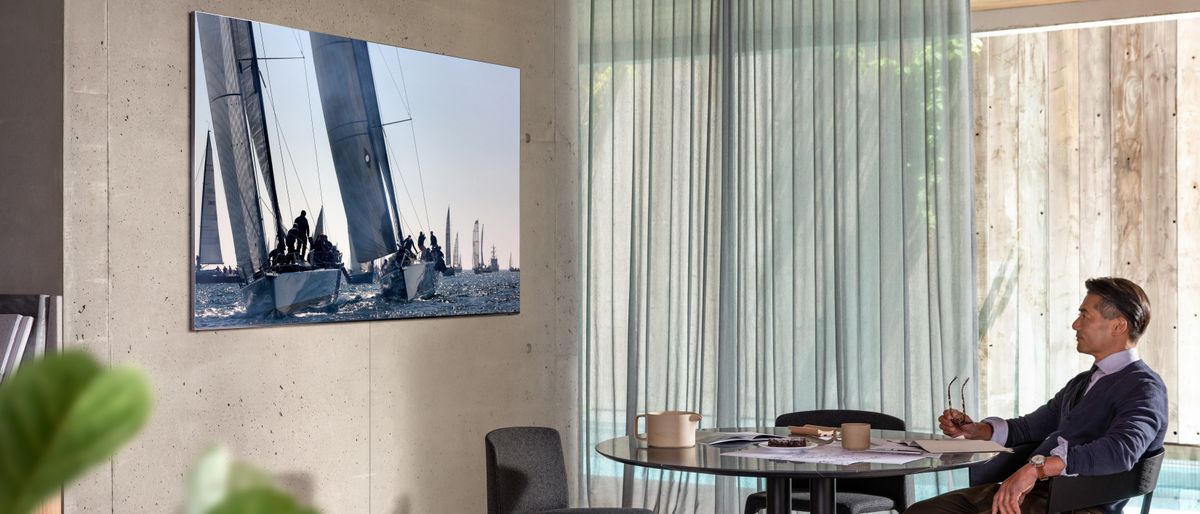TechRadar Verdict
While the lack of 8K content stings, and its lack of affordability is a high barrier to entry, the Samsung Q950TS 8K QLED TV is both a demonstration of what our future viewing might look like, and a shining example of just how good a TV can make 4K content look right now.
Pros
- +
Extraordinary upscaler
- +
Bright, detailed images
- +
Impressive design
Cons
- -
Expensive by any measure
- -
No Dolby Vision
- -
Little 8K content out there
Why you can trust TechRadar
The Samsung Q950TS is no longer the latest 8K flagship from the world's biggest TV brand – that moniker goes to the new QN900A we saw launched in 2021. But the Q950TS is still a notable 8K TV with impressive specs that might be worth eyeing up in any upcoming Black Friday sales.
There's an element to which the Q950TS is overspecified, no matter how much you spend on it. With 8K resolution, this screen will spend most of its processing power upscaling the SD, HD and 4K sources you put into it, given the sheer lack of native 8K content out there.
Yes, 8K cameras exist and yes, Netflix has apparently used one to develop some content. And yes, if this summer’s Tokyo Olympics don’t succumb to coronavirus paranoia then Japanese broadcaster NHK plans to broadcast the entire shebang in 8K. But really, 8K content in any meaningful quantity still looks a long way off.
So if it’s going to make any sort of case for itself at all, the Q950TS is going to have to perform miracles with the lower-resolution stuff it’ll spend all its time displaying. Thankfully, it absolutely does – and the overall quality of its images, audio, and feature set make it an astonishing entry into the 8K market.
This is a 2020 model, of course, so those of you after the latest new Samsung TVs should consider the Samsung QN900A or QN800A instead. Otherwise, read on for our full Q950TS review.
Price and release date
The Samsung Q950TS is Samsung's flagship 2020 QLED TV. US shoppers have a single 85-inch model, priced at $12,999 at launch.
For UK shoppers, it's pretty pricey at £7,999 for the 75-inch model (reviewed here), though you can shave that to £5,999 for the 65-inch – or bump it up to £11,999 for the 85-inch model.
These are only launch prices, though, and you should be able to find it for almost half price at all of these sizes now.
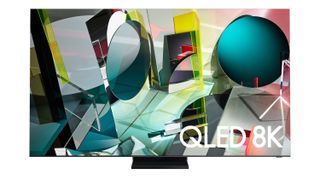
Design
Screen size: 75- and 85-inches | Tuner: RF, satellite | Panel technology: QLED | Panel resolution: 7680 x 4320 | Smart TV: Samsung/Tizen | HDR: Yes (HLG, HDR10, HDR10+) | Inputs: 4x HDMI (inc 1 x HDMI 2.1), 3 x USB, ethernet | Dimensions: 94 x 165 x 1.5 cm (HxWxD) | Weight: 36kg
Honestly, expectations are low when it comes to a TV's design. As long as the screen is big and the bezel isn’t, that’s pretty much job done.
And in the case of the Q950TS, Samsung has hit the bull’s-eye.
A 75-inch screen is big in anyone’s language, and Samsung has managed to wrap it in what is genuinely the briefest bezel ever seen on a production TV. At 2mm thick it’s virtually non-existent – and if you sit a sensible distance from this TV it genuinely does disappear from view. As party tricks go, this is a good one.
Almost as impressive is the chassis’ 15mm depth. Obviously QLED technology requires a layer of backlighting, so will never achieve the crowd-pleasing slimness of OLED, its chief rival, but because Samsung has taken all inputs, outputs and power requirements off-board, the Q950TS doesn’t have an OLED-style lump or bulge anywhere on the rear of its frame.
All the inputs – that’s four HDMI sockets (one of which is 2.1-specified), three USB inputs, RF and satellite TV aerial posts, an ethernet socket - are contained in the fairly sizeable One Connect box. It has a digital optical output too, and even takes care of mains power – just one modest connection to the TV itself is all that’s required. So if you intend to wall-mount your expensive new TV, it will sit almost flush.
If you don’t have a big enough bit of wall spare, though, the Samsung will quite happily sit on its centrally positioned pedestal. From here it leans back a little more than three degrees, in order to direct its screen at your eyes rather than at your belt-line. Because you’re not about to stand a TV this big on a high surface, are you? You don’t want watching TV to be like sitting too close to the screen in the cinema, after all...
Design TL;DR: Off-board connections, nicely slim chassis and extremely thin bezel makes for one of the most discreet 75-inch TVs around.
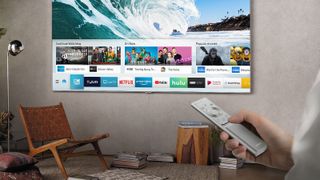
Smart TV (Tizen)
Given that its 2019 range of TVs were all possessed of the best smart TV/user interface around, Samsung has very sensibly decided against meddling with its winning formula. The Tizen-derived interface has had its background color amended from white to gentle blue in the name of reduced eye-strain, but in every other respect it’s the same logical, sensible, responsive and easy-to-customize system it’s always been. And it’s still absolutely loaded with apps.
The set-up menus governing picture quality are comprehensive, but not scarily so, and it’s neither tricky nor time-consuming to finesse the picture to suit your own requirements and preferences. And to this end the Samsung’s excellent remote control, which is weighty and not over-buttoned, helps a lot. So does the built-in Alexa functionality – and there’s Google Assistant compatibility to follow “soon”.
HD/SDR Performance
Really, if the Q950TS can look good dealing with this relatively poverty-stricken standard of resolution, then it’s home free. After all, the utter dearth of native 8K content means the Samsung is going to spend most of its life upscaling lower-spec stuff to fit its mighty 7680 x 4320 resolution – and a 1920 x 1080 Blu-ray disc of Douglas Gordon and Phillipe Perreno’s Zidane: A 21st Century Portrait delivers just over 2 million pixel’s-worth of information. Which leaves the Q950TS with over 30 million remaining pixels to fill with information.
Yet thanks in no small part to Samsung’s enormous AI and machine-learning efforts, the 75Q950TS is able to cross-reference the make-up of the image against its huge database of information. It can then have a far more educated stab at upscaling the picture to fit its colossal resolution than has ever been possible before.
There’s quite a lot of picture noise in the original material, about which the Samsung can do little. And in the 950TS’s hands there’s not what you’d call absolute certainty when it comes to defining the edges of objects or tracking a footballer’s relentless movement - but nevertheless the Samsung serves up a strikingly composed and convincing image.
It does remarkably good work where detail retrieval and the description of textures are concerned – it makes the Real Madrid shirt look just as shiny and combustible as we all remember it. Contrasts are strong, and detail levels remain high even in the brightest or darkest scenes. The Samsung’s ability to keep black tones differentiated and white tones clean – even when they’re on-screen simultaneously - is impressive on a fairly fundamental level.
Overall, it’s the clarity and confidence of the huge amount of upscaling that’s being done here that’s most striking. There’s no jaggedness, no overlapping and very little of the graininess that can be introduced when HD stuff is upscaled by some 4K screens – so for this 8K Samsung to look so composed is quite something.
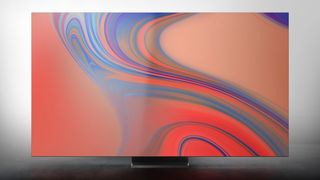
4K/HDR Performance
Given the Q950TS’s deeply impressive performance with high-def content, it doesn’t come as any great surprise to find the Q950TS does exemplary work when upscaling the 3840 x 2160 resolution of a 4K Blu-ray of Mad Max: Fury Road. The picture is truly superior to that of any number of well-regarded native 4K screens.
There isn’t an aspect of picture-making at which this Samsung doesn’t seem to excel. It summons extraordinary levels of brightness, it paints from a staggeringly expansive color palette, it reveals almost indecent levels of detail. Despite the hugely stylized nature of the film and its relentless motion, on-screen movement is controlled with an iron fist. Even the brightest white tones resist bleaching, and the deepest blacks retain detail.
The disc’s HDR-assisted images absolutely pop from the Q950TS – the overdriven red and orange tones, in particular, are capable of dealing with cataracts. But this is no blunt instrument: the Samsung’s full array backlighting (a total of 480 zones) is controllable down to a single individual zone. So even when the boldest, brightest colors are scorching from the screen, the darker areas of the scene remain convincingly dark. And only in the most trying circumstances does the backlighting make its presence felt.
The Samsung can’t rid the biggest, most uniform areas of color (which in this movie tends to mean either ‘the sky’ or ‘the desert’) of a smattering of picture noise, though - it’s about the only overt indication of just how hard the Q950TS’s upscaling engine is working.
In terms of control, dynamism and straightforward believability, the Q950TS will take some beating. Which is just as well, as it seems fated to spend the overwhelming majority of its time working to bring 4K images up to its native resolution.
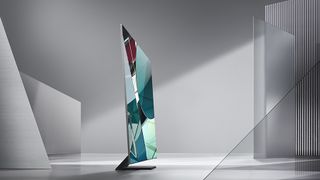
8K Performance
Oh, of course the Samsung looks nothing short of spectacular when displaying native 8K content. But unless you’re in a very privileged position, the 8K content you’ll get to see is the same as the 8K content I get to see: lovely electronics show-worthy shots of flowers opening, sumptuous panning shots of city-scapes, close-ups of pretty animals…
Yes, it all looks fantastic. Colorful, high-contrast, luxuriously detailed all that… but until there’s any meaningful 8K stuff available on disc or via streaming service, it shouldn’t really make any difference to your decision-making when it comes to getting your credit card out (or not) for the Q950TS.
Sound
You have to have some unique thought processes going on if you’re considering dropping a small fortune on a new TV yet not budgeting for an appropriate sound system to accompany it. But Samsung has nevertheless moved to address what was generally characterized as the ‘woeful’ sound of its 2019 8K models, by deploying something it’s calling ‘Object Tracking Sound +’.
Basically, this means an array of eight speaker drivers arranged in what Samsung’s describing as a ‘4.2.2’ arrangement. That means two midrange drivers firing from the top of the chassis, another pair of mids plus two low-frequency units firing from the bottom, and a tweeter at either side of the frame about halfway up. The idea is to both open up the soundstage and to offer a degree of audio tracking to whatever is happening on the screen.
In some respects it’s reasonably successful. Certainly the eight drivers and their 70 watts of total power produce a big, well separated sound - and there’s undeniably a degree of motion-tracking along with it. But the sonic signature is quite hard and thin, and so inappropriate for the opulence of the images it’s accompanying it’s almost funny.
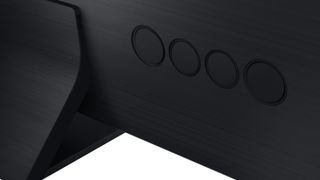
Other panels to ponder...
Well, last year’s Samsung 8K models are now available with some tempting discounts… but the Q950TS is a decent step on from any of those, so let’s not involve ourselves in any false economies.
A better bet would be to consider one of the world’s bigger and more accomplished 4K TVs, especially those with half-decent audio quality. And in that respect it’s hard to look beyond the remarkable Philips OLED+984. Admittedly it’s ‘just’ as 65-inch screen, but unlike the Samsung it’s a) equipped with Ambilight, b) includes Dolby Vision as well as HDR10+ dynamic metadata compatibility and c) sounds better than any other TV on the market thanks to its Bowers & Wilkins integrated soundbar.
And it’s roughly half the price of the 75Q950TS, so it leaves you enough money for a nice holiday or something.
Or you could go to the other extreme and spend five figures on the 85-inch Sony Z9G/ZG9 8K TV. It’s a bloater compared to the Samsung, both in screen size and chassis depth, but it’s a comparably impressive upscaler of 4K content. It’s not as bright as the Samsung, though, nor as adept with low-light detail.
Final verdict
The 75Q950TS is a very worthwhile advancement of the 8K art. Its native 8K images are almost humbling in their fidelity, and out in the real world it’s as good an upscaler of 4K content as you can buy at any price. The price, and the lack of native content, make it an undeniably idiosyncratic purchase, but it’s hard to imagine anyone watching the pictures it delivers and then wishing they hadn’t bothered.
- Expect to see the Q950TS on our list of the best 8K TVs
- Check out our review of the Samsung UE43RU7020 4K TV
- Roku vs Fire Stick: which streaming video devices are better?
- Check out the TV reviews that we've published recently: the TCL EP658, the TCL C81, the Hisense U8QF, the Panasonic HX940, the Philips 9435, the Hisense HU7B.
- Get the best deal on Samsung products with our Samsung coupon codes.
Simon Lucas is a senior editorial professional with deep experience of print/digital publishing and the consumer electronics landscape. Based in Brighton, Simon worked at TechRadar's sister site What HiFi? for a number of years, as both a features editor and a digital editor, before embarking on a career in freelance consultancy, content creation, and journalism for some of the biggest brands and publications in the world.
With enormous expertise in all things home entertainment, Simon reviews everything from turntables to soundbars for TechRadar, and also likes to dip his toes into longform features and buying guides. His bylines include GQ, The Guardian, Hi-Fi+, Metro, The Observer, Pocket Lint, Shortlist, Stuff T3, Tom's Guide, Trusted Reviews, and more.
